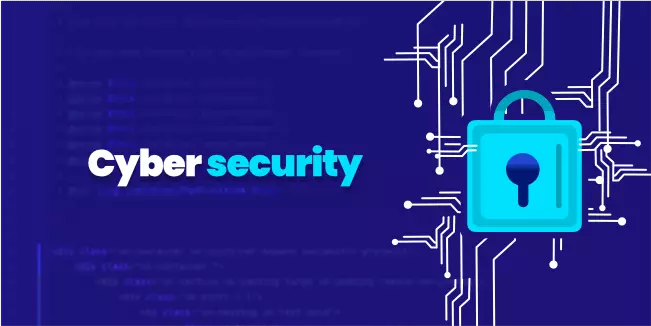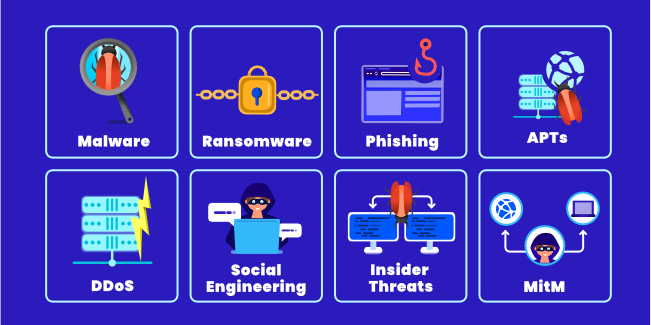Everything you need to know about Cybersecurity

Progressing digitization creates many new opportunities for companies in almost every industry. However, this comes with digital security risks that need to be addressed. With the proliferation of e-commerce and cloud technology in almost every sector, protection against cyberattacks is now essential to any business's success. In addition, for software development companies, ensuring the security of the created mobile applications and software allows them to gain a competitive advantage in the IT outsourcing market.
According to Accenture, 43% of cyberattacks target small businesses, but only 14% are prepared for it. Cybersecurity knowledge is crucial at every stage of the company's development and thinking: "this does not apply to my industry," is one of the biggest cybersecurity myths. It is worth realizing that individuals, small companies, giant corporations, and government institutions are exposed to hacker attacks. The difference is that large companies and organizations tend to be more aware of this type of problem.
What is Cybersecurity?
Cybersecurity protects computer systems and technologies, including hardware, software, and data, from cyber attacks. Both individuals and companies use it to stop unauthorized access to their IT networks or databases. It is a critical practice to ensure that sensitive information is protected.
Cybersecurity is critical to protecting enterprises from cyberattacks, limiting their impact on operations, and securing all the devices and services they use. For organizations, it is essential to ensure that they have effective security measures in place to protect against cyber threats.
Companies implement many measures, such as innovative technologies, security controls, quality procedures, and defensive approaches to protect their digital information from malicious attacks.
Why is Cybersecurity Important?
Mobile devices, smartphones, computers, and tablets are now essential in our daily professional and private lives, which is why cyber security has become a top priority. We rely on the Internet for many aspects of our business, and we must remember that we store important employee and customer data in cloud networks. For this reason, we must take steps to protect these valuable resources safely.
Dependence on digital tools puts many companies at risk from cyberattacks. Solid cybersecurity knowledge is crucial here because such attacks are constantly developing and becoming more and more advanced. Cyberattack victims may be exposed to the loss of sensitive information, data breaches, and financial losses, which in serious cases, can lead to the company's collapse.
Knowledge of minimizing the risk of cyberattacks and ensuring critical infrastructure security is essential in every company.
What are the Key Elements of Cybersecurity?
There is no one-size-fits-all solution in cybersecurity because we deal with known and unknown threats. Therefore, you should look at the different areas relevant to your business and then secure them accordingly. The most critical elements of cybersecurity that companies should focus on are:
Critical Infrastructure Security
These are the practices of protecting computer systems, networks, and other resources on which the functioning of your company is based. In some countries, various departments and associations are creating cybersecurity frameworks to help companies and organizations in this regard. The Department of Homeland Security helps companies in the USA by publishing additional guidance and information about new types of threats.
Network Security
Network security is essential for any business, and network administrators are responsible for ensuring robust protection through policies such as strong passwords, firewalls, encryption technology, and anti-virus software. It ensures that only authorized users have access to essential data or systems.
Application Security
Various measures can be taken to ensure the security of applications running on-premises and in cloud environments. To guarantee optimal defense, security must be part of the application design from the start - consulting user authentication protocols and data management processes.
Cloud Security
Cloud security is critical for both customers and businesses. It ensures complete confidentiality by encrypting data during storage, transfer to and from the cloud, and processing. It guarantees the safe use of private information and complies with applicable legal regulations.
Mobile and IoT Security
With the rise of mobile security and IoT-powered devices such as smartphones, tablets, and other internet-connected gadgets, there is a greater need to prioritize them for cybersecurity.
Information Safety
Information security protects the most confidential data against theft, disclosure, and unwanted access. Using data protection measures ensures that sensitive information remains secure at all times.
Employee Education
Strengthening security throughout the organization starts with employee education. Employees should be educated on detecting potential threats, such as removing suspicious email attachments or refraining from using unknown USB devices. By developing security awareness and training your employees on proper security protocols, you can ensure your business is well protected against cyberattacks.
Business Continuity and Disaster Recovery Planning
Disaster recovery and business continuity are invaluable in emergencies such as natural disasters, power outages, or cyber threats. Practical tools and procedures will ensure that your critical operations experience little or no disruption.
What are the Different Types of Cybersecurity Threats?

As more and more companies realize the importance of protecting their assets, hackers and cybercriminals are developing increasingly sophisticated forms of attacks, which unfortunately continue to evolve. The most notorious cyberattacks include:
Malware
Malware is a sneaky type of malicious software or file that can be used to disrupt and damage computers. Typical forms of malware include worms, viruses, Trojans, and spyware. These malicious programs can wreak havoc on your computer's security if not identified quickly.
Ransomware
Ransomware is malware that locks user data and files, usually by encryption. The attacker then extorts money from the targeted person or organization to decrypt and unlock their system.
Social Engineering
Social engineering is a cyber attack that relies on human interaction to trick users into breaching security procedures and obtaining confidential information. By exploiting people's trust, hackers gain access to valuable data that is usually protected. This method can be used in many ways, from phishing attempts to spoofing attempts.
Phishing
Phishing is a malicious social engineering tactic that involves sending fake text messages or emails that appear to come from well-known companies. The purpose of these insidious messages is to steal sensitive data, including credit card details and bank account login details. Successful phishing attempts often result in losing all funds in bank accounts.
Insider Threats
Insider threats are security breaches or losses caused by people, employees, contractors, or customers. Insider threats can be malicious or negligent.
Distributed Denial of Service (DDoS)
Distributed Denial of Service attacks are malicious cyberattacks where attackers flood a network or server with excess messages, packets, and connection requests. This attack can be catastrophic to the target system, causing it to crash completely or slowing down significantly - preventing legitimate traffic from using it.
Advanced Persistent Threats (APTs)
Advanced Persistent Threats are malicious, targeted cyber attacks designed to infiltrate networks and remain undetected for extended periods to obtain sensitive data.
Man-in-the-Middle (MitM) Attacks
Using malicious eavesdropping tactics known as man-in-the-middle (MitM) attacks, cybercriminals can intercept and manipulate messages sent between two parties that mistakenly assume they are communicating directly with each other.
What are the cybersecurity challenges?
Cyberattacks are not expected to decrease in the foreseeable future. On the contrary: the number of cyberattacks will increase, and they will constantly evolve. Therefore, it is worth paying attention to the following cybersecurity challenges that have an impact on ensuring an adequate level of protection:
Evolving Threats
Cybersecurity is an ever-evolving challenge due to rapid technological advances leading to the emergence of new attack methods. Staying updated with these changes and strengthening our security practices against them can be daunting. For this reason, you must be vigilant and regularly track these changes to keep safe. Maintaining all cybersecurity elements to fend off potential vulnerabilities is challenging, especially for smaller organizations with limited staff and resources.
A Deluge of Data
Companies collect more and more data, which is a tasty morsel for hackers. As more data is collected, the likelihood of a data breach increases. Organizations should do everything in their power to protect data from theft.
Cybersecurity Awareness Training
Employee education is an essential component of any cybersecurity program. Employees can unknowingly transfer threats and vulnerabilities to their mobile devices or even click on links in phishing emails without realizing the consequences. Nevertheless, through regular security awareness training, employees can be equipped with the knowledge to protect the company more effectively against cyber threats.
Shortage of Security Experts
With the increasing amount of data collected and used by businesses, there is a growing need for competent cybersecurity experts to assess, oversee and respond to incidents.
Of course, you can take care of the security of your resources on your own, but our experience shows that it is difficult for companies to create a team of highly qualified security specialists, including a chief information security officer, security engineers, security analysts, and security architects. It is due to both the availability of such specialists and financial issues. Therefore, it is worth considering cooperation with a company that deals with cyber security and has appropriate specialists in its ranks.
Supply Chain Attacks and Third-Party Risk
The security challenges arising from attacks on the hardware and software supply chain continue to grow, requiring organizations to address third-party risks throughout their lifecycle. One way to mitigate this risk is to use the Software Bill Of Materials (SBOM), which creates an inventory list of all components used in a given software or system. Implementing SBOM helps organizations identify potential issues before they become significant vulnerabilities.
Summary
Your company's existence may depend on ensuring the appropriate level of cybersecurity. Hacker attacks and other security threats affect everyone, regardless of the industry in which they operate. Protecting against cyberattacks is difficult but possible, provided that professionals deal with the subject. The issue of security should be a key issue from the beginning of each application or software development process. Therefore, it is not surprising that a methodology like DevSecOps is popular, introducing cybersecurity from the beginning of the software development cycle.
If you want to be sure that your website or application will be safe, consider working with a company that has been creating safe and successful digital products for over a dozen years. You can talk about your project anytime with our specialists during a free consultation. We love to share our knowledge and experience with those looking for good solutions.